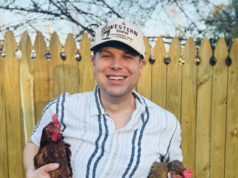
Dallas Morning News arts columnist Michael Granberry could have gone to just about any college in 1969 when he was an 18-year-old kid bound and determined to become a working journalist.
He chose Southern Methodist University for one reason — the college had beefed up its journalism department by adding Jay Milner to its staff. Later, Milner would teach at Texas Christian University.
“Jay’s approach was different — totally outside the box,” Granberry recalled this afternoon while speaking at TCU.

Three students were given money and plaques as the first recipients of the Jay Milner Distinguished Student Journalism Awards. Granberry’s fond recollections helped flesh out the man whose name is on the award.
Fort Worth Weekly published a cover story on local author, columnist, college teacher, and reformed roustabout Milner way back in 2002. He ran with a wild bunch of writers in the 1950s who referred to themselves as “Maddogs.” Bud Shrake, Gary Cartwright, Dan Jenkins, and Larry L. King were among the informal members.
In the 1970s Milner was one of Willie Nelson’s publicists and party buddies. Milner even got married at the home of Texas Music icon Jerry Jeff Walker back in the day. He later wrote about those years in Confessions of a Maddog: A Romp Through the High-Flying Texas Music and Literary Era of the Fifties to the Seventies.

He quit the booze, speed, and fast-living when he reached middle-age and then settled down in Fort Worth and became something of a recluse, devoting the last part of his life to his family — wife, Gail, and their children and grandchildren.
Milner was devoted to teaching young people to write stories that matter, and the award in his name was established to recognize TCU’s top journalism students after Milner died in December. He was 88.



Here’s a transcript of Michael Granberry’s speech, which was wonderful because it made Milner into flesh and blood for the TCU students rather than just a name on a plaque:
The first time I met Jay Milner, he was sitting in his office at Southern Methodist University. It was August 1970. I was 18, he was 45. Mounted on the wall behind Jay’s desk was a striking black-and-white photograph, taken by Pulitzer Prize winner (and close Milner friend) Shel Hershorn. It was a picture of a coyote lying dead on a highway. Wow, I thought. None of my teachers in high school ever had a picture like that behind their desk.
Jay didn’t know it, and I didn’t tell him, but he was the reason I had chosen SMU. Months before graduating from high school, I had read a story in The Dallas Morning News about two new professors who were overhauling SMU’s journalism department by taking a radically different approach. They were published novelists whose books had garnered rave reviews. Milner had written Incident at Ashton, a 1961 novel about racial injustice, inspired by his having been a reporter in Mississippi in the 1950s. As I understand it, it was based largely on the Emmett Till case. Emmett was a 14-year-old black boy who was murdered after allegedly flirting with a white woman. The white men who killed him, who beat him and gouged out one of his eyes before shooting him, were acquitted. Emmett’s mother insisted on an open casket, so that everyone could see the brutality of what had happened to her boy. Jay called it the most important story he had ever covered. It also allowed him to meet a rookie reporter named David Halberstam, who just a few years later won the Pulitzer Prize for his reporting from Vietnam for the New York Times. He, too, considered Jay a mentor.
Jay’s partner in the SMU experiment was William Brammer, who wrote The Gay Place, the critically acclaimed novel about Texas politics that focused loosely on Lyndon Baines Johnson. I never met Brammer during my time at SMU; he had pretty much faded from the scene by the fall of ’69. Jay was running the department all by himself, and he alone made it extraordinary.
My high school journalism teacher, Dorothy Earle (now Dorothy Lougheed) cleverly realized that the Milner-Brammer partnership made SMU just about the coolest alternative of all. These were novelists, whose broader approach to teaching journalism eliminated having to take 100 hours of stupid courses on writing headlines and the like. We could take courses in English, sociology and political science and learn Journalism 101 at the student daily, where Milner all but demanded we work. Small was good, big was bad. Jay believed in whatever the opposite was of the sterile, “factory” approach to the teaching of journalism at bigger universities. Many of those, of course, were schools with the so-called good reputations, but he didn’t care. He knew exactly how he wanted to teach.
As a result, I met some of the most talented people I’ve ever known at SMU. They made working at The Daily Campus a terrific time.
Milner left SMU after my sophomore year, but during the years he spent on the Hilltop, I met several of his literary chums – Edwin “Bud” Shrake, Gary Cartwright, Larry L. King and Pete Gent, the former Dallas Cowboys wide receiver who wrote a landmark novel about professional football titled North Dallas Forty that became a hit movie starring Nick Nolte. Meeting such proven writers was incredibly valuable. Before I arrived at SMU, some of my older classmates took an “Interterm” course and got to meet Halberstam and Larry McMurtry, who had known Jay for years. But we didn’t love Jay because of them. We loved Jay because of Jay.
Jay’s approach was different, totally outside the box, and even to this moment, I find myself learning from him through the Milnerian voice that remains forever inside my brain. During my sophomore year, Dallas Cowboys running back Duane Thomas was causing controversy. He ended up leading the Cowboys to their first Super Bowl championship in 1971, but judging by the local papers, Duane was an evil pariah, a Judas. He had taken a vow of silence, refusing to talk to teammates or sportswriters, especially sportswriters, who collectively tried and convicted him each day in the Dallas papers. Milner taught me to look beyond such shallow, judgmental reporting, to try to have empathy with Duane’s frustrations. As his friend Gay Talese once said, “Strive for insight, not judgment.” Talese wrote a terrific book about the Mafia that followed that philosophy. Sports reporters, especially of that era, Jay warned us, were too often tools of management. I came to learn later, after doing a front-page profile on Duane for The Dallas Morning News in 2004, that the other side of the story, Duane’s side — the side that only Jay had helped me see — had gone totally unreported. Since then, I have come to be friends with Duane and have told him repeatedly about the teacher who caused us to see the Duane Thomas story in a different light. “What can I say?” Duane said. “I wish I had known the man.”
Jay taught us to be brave. During my sophomore year at SMU, I heard that SMU, which had one of the best golf teams in the nation, was refusing to recruit the top high school golfer in the nation, who was being recruited by everybody, except SMU, the school he wanted to attend. He was a Dallas kid, with very good grades. So why wasn’t SMU recruiting him? Well, I learned, he happened to be black.
I asked Jay’s advice. He said, “All you can do is call up the coach and ask him. Maybe he’ll tell you.” Boy, did he tell me. Even though it was 1972, eight years after the passage of the Civil Rights Act, SMU was choosing not to recruit the top high school golfer in the nation, an impeccable student, because he was black. The coach said it would pose a problem at the private country club where SMU practiced and played its matches. I returned to Jay for more advice. He said, “Don’t stop there. See who owns the country club. See if they agree with the coach’s decision.” Well, as it turns out, the coach was also developer and part owner of the country club. I ran my story, which got picked up by both Dallas newspapers and Jim Lehrer’s Newsroom show on KERA, Channel 13. The story exploded. SMU athletic director Hayden Fry, who six years earlier had broken the color line in Southwest Conference football, fired the golf coach, despite his winning record.
“Welcome to journalism,” Jay said. “That was one hell of a story.” When the Washington Post hired me as an intern during the Watergate summer of 1973, they told me the golf story was the sole reason they were hiring me.
In 1982, I was a full-time sportswriter, trying to follow Jay’s lessons in covering the National Basketball Association for the Los Angeles Times. During a game between the San Diego Clippers and Portland Trail Blazers, I looked behind my seat and saw David Halberstam. He was doing a book on the NBA called The Breaks of the Game. I told him about being a protégé of the great Jay Milner, which was all I needed to say. We stayed up until 2 a.m. that night, eating cheap Chinese food and talking until they kicked us out. When Halberstam graduated from Harvard, he headed to the racist wilderness of Mississippi, where a 14-year-old boy could be murdered for nothing. David believed that any journalist worth his salt had a responsibility to be in Mississippi, just as Jay Milner did. It was obvious that David cared deeply about Jay. For as long as I knew David, who died tragically in 2007 in a Bay Area car wreck, he asked me about Jay every time I saw him.
In thinking over what I would say today, my mind kept retreating to that initial meeting, to the affable, avuncular professor who put me totally at ease, even with a dead coyote leering over his shoulder.
Why a coyote, lying on a highway? Jay didn’t care about having pretty things on the wall or self-congratulatory things. Like any good writer, he cared about truth and the power of symbolism.
Jay asked during our initial meeting if I happened to have with me anything I had written. Well, yes, I said, I do. I handed him my first-ever story for the SMU paper, on star basketball player Gene Phillips. As Jay started to read it, he took out a big black pen and started making crude marks and circles all over the manuscript, which he did with everything I ever showed him. He taught me a valuable lesson in the very first piece of mine he edited. “You see that word that you’ve used right there,” he said, squinting through his glasses. “That word there. Bevy. B-e-v-y. Never use that word again. That’s the kind of word sportswriters love to use. And I want you to be different from them. Writing is mainly about a sense of surprise. You’ve got to surprise people. So use a word there that they won’t expect. You just have to change that one word. So, instead of bevy, use the word … flock. The reader won’t expect that, and that one word will cause their mind to feel intrigued. You will have tripped them up, and they won’t even know it.” What great advice. Read any great writer, such as Larry McMurtry or Gay Talese or Jay Milner or F. Scott Fitzgerald, and you’ll know exactly what Jay meant.”
As I stand before you today, I can think of no man better suited for TCU to honor. For I am merely one member of a proud flock happy to call Jay Milner my good friend and lifelong teacher.












Thanks for sharing the day with us. We are so very pleased about the recognition of a real great man and father. We are happy for what this will do for the students and how proud of their accomplishments Daddy would be.
A great day for Schieffer School of Journalism too.